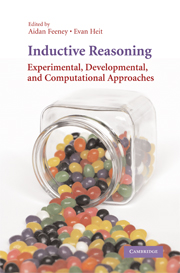Book contents
- Frontmatter
- Contents
- List of Figures
- List of Tables
- List of Contributors
- Preface
- 1 What Is Induction and Why Study It?
- 2 The Development of Inductive Reasoning
- 3 Interpreting Asymmetries of Projection in Children's Inductive Reasoning
- 4 Property Generalization as Causal Reasoning
- 5 Availability in Category-Based Induction
- 6 From Similarity to Chance
- 7 Theory-Based Bayesian Models of Inductive Reasoning
- 8 Use of Single or Multiple Categories in Category-Based Induction
- 9 Abductive Inference: From Philosophical Analysis to Neural Mechanisms
- 10 Mathematical Induction and Induction in Mathematics
- 11 Induction, Deduction, and Argument Strength in Human Reasoning and Argumentation
- 12 Individual Differences, Dual Processes, and Induction
- 13 Taxonomizing Induction
- Index
2 - The Development of Inductive Reasoning
Published online by Cambridge University Press: 26 February 2010
- Frontmatter
- Contents
- List of Figures
- List of Tables
- List of Contributors
- Preface
- 1 What Is Induction and Why Study It?
- 2 The Development of Inductive Reasoning
- 3 Interpreting Asymmetries of Projection in Children's Inductive Reasoning
- 4 Property Generalization as Causal Reasoning
- 5 Availability in Category-Based Induction
- 6 From Similarity to Chance
- 7 Theory-Based Bayesian Models of Inductive Reasoning
- 8 Use of Single or Multiple Categories in Category-Based Induction
- 9 Abductive Inference: From Philosophical Analysis to Neural Mechanisms
- 10 Mathematical Induction and Induction in Mathematics
- 11 Induction, Deduction, and Argument Strength in Human Reasoning and Argumentation
- 12 Individual Differences, Dual Processes, and Induction
- 13 Taxonomizing Induction
- Index
Summary
From one perspective virtually every cognitive act carried out by young children involves induction. Compared to older children and adults, young children have little background knowledge about the world and have only a shaky grasp of the rules that govern propositional reasoning. They are continually faced with the task of making inferences based on their past observations and experience. This is true whether the child is trying to determine which kinds of animals have red blood cells, whether a specific tool can be used to assemble a bike, or whether the new kid who has moved next door is likely to be friendly. This chapter focuses on a particularly important aspect of the development of inductive reasoning – the way that children use their understanding of categories and category structure to generalize attributes from familiar to novel instances.
Category-based induction typically involves three components. First, observing that an inductive base or “premise” has the property P (e.g., that a shark has fins); second, deciding that X and a target or “conclusion” item Y are related in some way (e.g., that a shark and a trout are both fish); and third, inferring whether Y shares property P.1 Investigating children's inductive reasoning allows us to determine when this reasoning ability first emerges and to chart important age-related changes in induction. It is also a valuable tool for understanding the development of children's category representations. In fact, some important theories of conceptual development (e.g., Carey, 1985) have been based, for the most part, on the results of studies of age changes in children's inductive generalizations.
- Type
- Chapter
- Information
- Inductive ReasoningExperimental, Developmental, and Computational Approaches, pp. 25 - 54Publisher: Cambridge University PressPrint publication year: 2007
- 11
- Cited by

